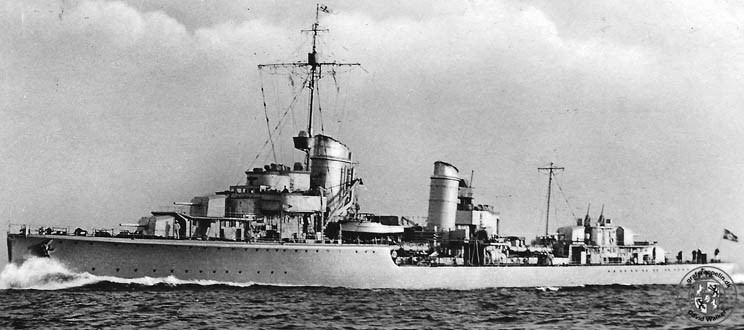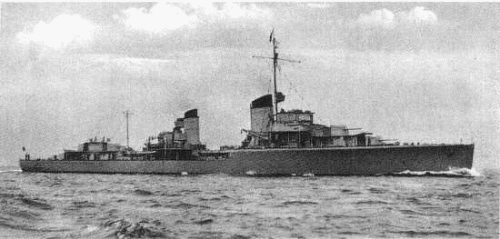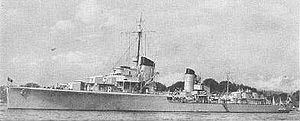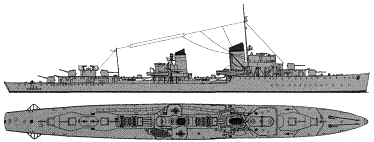Ordered 7 July 1934 Commissioned 14 January 1937 Launched 18 August 1935 Beam 11 m | Laid down 15 October 1934 Construction started 15 October 1934 Length 119 m | |
 | ||
Fate Sunk by naval mine or bombs, 22 February 1940 Similar German destroyer Z3 Max Schultz, German cruiser Admiral Hipper, German destroyer Z4 Richard Beitzen | ||
The German destroyer Z1 Leberecht Maass was a Type 1934 destroyer built for the Kriegsmarine during the 1930s. The ship was named after Rear Admiral Leberecht Maass who commanded German forces in the Battle of Heligoland Bight in August 1914. Several days after the start of World War II, she unsuccessfully attacked, together with another destroyer, Polish ships anchored at the naval base on the Hel Peninsula. Leberecht Maass was lightly damaged during the action. In mid-February 1940, while proceeding into the North Sea to search for British fishing trawlers, the ship was bombed by a patrolling German bomber that damaged her steering. She either drifted into a newly laid British minefield or was again hit by bombs and broke in half with the loss of the bulk of her crew.
Contents

Design and description

Leberecht Maass had an overall length of 119 meters (390 ft 5 in) and was 114 meters (374 ft 0 in) long at the waterline. The ship had a beam of 11.30 meters (37 ft 1 in), and a maximum draft of 4.23 meters (13 ft 11 in). She displaced 2,223 long tons (2,259 t) at standard load and 3,156 long tons (3,207 t) at deep load. The two Wagner geared steam turbine sets, each driving one propeller shaft, were designed to produce 70,000 PS (51,000 kW; 69,000 shp) using steam provided by six high-pressure Wagner boilers. The ship had a designed speed of 36 knots (67 km/h; 41 mph), but her maximum speed was 38.7 knots (71.7 km/h; 44.5 mph). Leberecht Maass carried a maximum of 752 metric tons (740 long tons) of fuel oil which was intended to give a range of 4,400 nautical miles (8,100 km; 5,100 mi) at a speed of 19 knots (35 km/h; 22 mph), but the ship proved top-heavy in service and 30% of the fuel had to be retained as ballast low in the ship. The effective range proved to be only 1,530 nmi (2,830 km; 1,760 mi) at 19 knots.

The ship carried five 12.7 cm SK C/34 guns in single mounts with gun shields, two each superimposed, fore and aft. The fifth gun was carried on top of the aft superstructure. Her anti-aircraft armament consisted of four 3.7 cm SK C/30 guns in two twin mounts abreast the rear funnel and six 2 cm C/30 guns in single mounts. The ship carried eight above-water 53.3-centimeter (21.0 in) torpedo tubes in two power-operated mounts. A pair of reload torpedoes were provided for each mount. Four depth charge throwers were mounted on the sides of the rear deckhouse and they were supplemented by six racks for individual depth charges on the sides of the stern. Enough depth charges were carried for either two or four patterns of 16 charges each. Mine rails could be fitted on the rear deck that had a maximum capacity of 60 mines. A system of passive hydrophones designated as 'GHG' (Gruppenhorchgerät) was fitted to detect submarines. The crew numbered 10 officers and 315 enlisted men, plus an additional four officers and 19 enlisted men if serving as a flotilla flagship.
Service history

Leberecht Maass was the first destroyer to be built in Germany since World War I. The ship was ordered on 7 July 1934 and laid down at Deutsche Werke, Kiel, on 10 October 1934 as yard number K232. She was launched on 18 August 1935 and completed on 14 January 1937. She became the flagship of the Führer der Torpedoboote (Chief of Torpedo Boats) upon commissioning. Leberecht Maass spent most of her first year training and made a port visit to Gothenburg in April 1938. Upon her return she was taken in hand by Deutsche Werke to have her bow rebuilt to reduce the amount of water that came over the bow in head seas. The ship participated in the August 1938 Fleet Review and the following fleet exercise. In December, Leberecht Maass, together with her sisters Z2 Georg Thiele, Z3 Max Schultz, and Z4 Richard Beitzen, sailed to the area of Iceland to evaluate her seaworthiness in a North Atlantic winter with her new bow. On 23–24 March 1939, the ship was one of the destroyers that escorted Adolf Hitler aboard the pocket battleship Deutschland to occupy Memel. She participated in the Spring fleet exercise in the western Mediterranean, as the flagship of Rear Admiral Günther Lütjens, and made several visits to Spanish and Moroccan ports in April and May.

On 3 September 1939, Z1 Leberecht Maass and Z9 Wolfgang Zenker took part in an attack on the Polish ships Gryf and Wicher in Gdynia harbour. The Poles replied effectively and forced the German destroyers to make evasive maneuvers and to lay a smoke screen to throw off the aim of the Polish gunners. Leberecht Maass was hit in the superstructure by a 152-millimeter (6.0 in) shell from the coast defense battery at Hel that killed four crewmen and wounded another four men. Lütjens ordered the action broken off 40 minutes later as the German fire was ineffective. The following day, she sailed to Swinemünde to have her damage repaired, a process that took until 10 September. After its completion, Leberecht Maass helped to lay defensive minefields in the North Sea. The ship began a scheduled refit in Swinemünde on 29 September and Lutjens transferred his flag to Z21 Wilhelm Heidkamp. She was attached to the 2nd Destroyer Flotilla on 22 December.
On 22 February 1940, Leberecht Maass and five other destroyers, Z3 Max Schultz, Z4 Richard Beitzen, Z6 Theodor Riedel, Z13 Erich Koellner and Z16 Friedrich Eckoldt, sailed for the Dogger Bank to intercept British fishing vessels in "Operation Wikinger". En route, the flotilla was erroneously attacked by a Heinkel He 111 bomber from KG 26. Leberecht Maass was hit by at least one bomb, lost steering, and broke in half, sinking with the loss of 280 of her crew, among them the ship's commanding officer, Korvettenkapitän Fritz Bassenge. Only 60 men were saved. During the rescue effort, Z3 Max Schultz hit a mine and sank with the loss of her entire crew. Hitler ordered a Court of Inquiry to be convened to investigate the cause of the losses and it concluded that both ships that been sunk by bombs from the He 111. The Kriegsmarine had failed to notify its destroyers that the Luftwaffe was making anti-shipping patrols at that time and had also failed to inform the Luftwaffe that its destroyers would be at sea. Postwar evidence revealed that one or both ships struck a British minefield laid by the destroyers Ivanhoe and Intrepid.
